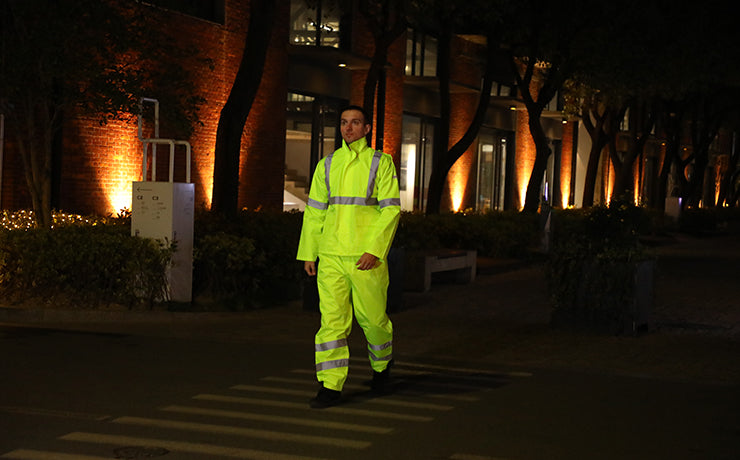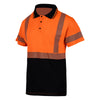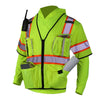Hi-Vis Clothes Cleaning Guide: How to Wash, Dry & Remove Stains
High visibility clothing, often abbreviated as hi-vis, plays a crucial role in ensuring safety in various work environments. From construction sites to roadside emergency scenarios, these vibrant and reflective garments make sure that wearers are easily seen, reducing the risk of accidents.
However, the effectiveness of hi-vis clothing heavily relies on its condition. Proper maintenance, which includes washing, drying, and stain removal, is essential to preserve the garment's protective qualities and its high visibility.
In this guide, we'll delve into the essential steps and considerations to keep your hi-vis apparel in top condition, ensuring your safety and the longevity of the clothing.
Table of contents:
- Understanding Hi-Vis Clothing
- Pre-wash Considerations
- Washing Hi-Vis Clothing
- Drying Hi-Vis Clothing
- Stain Removal Techniques
- Maintaining Reflective Qualities
- Special Considerations
- Conclusion
Understanding Hi-Vis Clothing
High visibility clothing is a type of safety apparel designed to make the wearer more visible in low light conditions or against a complex background. The primary purpose of hi-vis clothing is to enhance safety by making individuals stand out in environments where visibility is critical. This is particularly important in areas with moving vehicles or machinery, where being seen can be a matter of life and death.

Types of Hi-Vis Clothing and Their Common Uses
Hi-vis clothing comes in various forms, each serving a specific purpose:
-
Safety Vests: Often used in traffic control, construction sites, and by emergency responders. These vests are lightweight and can be worn over other clothing.
-
Hi-Vis Jackets: Ideal for colder environments or night work, these jackets provide both warmth and visibility.
-
Reflective Vests: Commonly used by cyclists, runners, or road workers, these vests are equipped with reflective stripes to enhance visibility at night.
-
Hi-Vis T-Shirts and Polo Shirts: Suitable for warmer climates, offering visibility while ensuring comfort.
-
Hi-Vis Trousers: Used in conjunction with other hi-vis gear to provide full-body visibility, often seen in railway and highway maintenance work.
Materials Commonly Used in Hi-Vis Clothing
The effectiveness of high-visibility jackets, vests, and other apparel is largely dependent on the materials used. These typically include:
-
Fluorescent Material: Brightly colored fabrics that are highly visible during the day.
-
Reflective Tape or Stripes: Often made from microscopic glass beads or prismatic materials, these reflect light, making the garment visible in low-light conditions.
-
Breathable Synthetic Fabrics: Materials like polyester ensure durability and comfort, especially in hi-vis jackets and shirts.
Pre-Wash Considerations

1. Inspecting Clothing for Damage or Wear
Before washing your hi-vis gear, it's crucial to inspect it for any signs of damage or wear. Check for tears, loose threads, or fading, as these can compromise the garment's protective qualities. Pay particular attention to the condition of the reflective tape or stripes, as damage to these areas significantly reduces visibility.
2. Reading and Understanding Care Labels
Each hi-vis garment comes with care labels that provide specific instructions for washing and drying. It's essential to follow these guidelines to avoid damaging the fabric or reflective properties. Common instructions include recommendations for washing temperature (usually cold water), the type of detergent (typically a mild detergent), and warnings against using bleach or fabric softener.
Learn more about the care labels from: How to Clean Your High-Visibility Jacket Without Damaging It?
3. Sorting Hi-Vis Clothes from Other Laundry
Hi, vis clothing should be washed separately from regular laundry to prevent color transfer and to ensure that the reflective tape and fluorescent materials are not damaged. Additionally, washing hi-vis apparel with similar colors and materials helps maintain the fabric's quality and reflective properties.
Washing Hi-Vis Clothing

Proper care of hi-vis clothing not only extends its lifespan but also ensures that it retains its safety features. Here's a detailed step-by-step guide to effectively wash your hi-vis apparel:
-
Pre-Treat Stains: If your hi-vis clothing has stains, pre-treat them with a mild stain remover. Be cautious not to use harsh chemicals that could damage the fabric or reflective elements.
-
Remove Loose Dirt: Before washing, shake out the garments to remove any loose dirt or debris. This helps to prevent any abrasive damage during the washing process.
-
Turn Garments Inside Out: This helps protect the reflective tape and the outer surface of the fabric from wear and tear during the wash.
-
Fill the Washing Machine with Cold Water: Use cold water for washing hi-vis clothing to prevent fading and shrinking.
-
Add a Mild Detergent: Choose a detergent that is gentle on fabrics. Avoid using bleach or fabric softeners, as these can degrade the fabric's quality and reflective properties.
-
Set to Gentle Cycle: Use a gentle wash cycle to prevent damaging the garment. If your washer has a ‘hand wash’ cycle, that’s an ideal choice.
-
Rinse Thoroughly: Ensure all soap is rinsed out, as residue can affect the garment's color and reflective capabilities.
-
Remove Promptly After Washing: Letting hi-vis clothing sit in the washer can cause colors to bleed or reflective tape to peel.
Choosing the Right Detergent and Water Temperature
Opt for a mild detergent that is free from harsh chemicals. This helps in maintaining the fabric integrity and reflective properties of the safety gear. Note, always use cold water, as hot water can cause fading and can damage reflective tape.
Machine Wash vs. Hand Wash: Pros and Cons
Machine Wash:
-
Pros: More convenient and less time-consuming. Suitable for lightly soiled hi-vis clothing.
-
Cons: Can be harsher on the fabric, especially if the washer is overfilled or the wrong cycle is used.
Hand Wash:
-
Pros: Gentler on the fabric, offering more control over the washing process. Ideal for heavily soiled or delicate hi-vis apparel.
-
Cons: More time-consuming and requires more effort.
Tips to Prevent Fading and Maintain Visibility
-
Wash Hi-Vis Clothing Separately: This prevents color transfer from other clothes and reduces wear on reflective materials.
-
Use a Mild Detergent and Cold Water: Helps in maintaining color and fabric integrity.
-
Avoid Direct Sunlight When Drying: Line dry the garments in a shaded area to prevent fading.
-
Regular Checks: Regularly inspect the reflective tape and fabric for signs of wear.
-
Limit Wash Frequency: Wash hi-vis garments only when necessary to reduce wear and tear.
Related: How to Clean Your High-Visibility Jacket Without Damaging It?
Drying Hi-Vis Clothing

After washing hi-vis clothing, the way you dry it is equally crucial in maintaining its safety features and overall quality. Here are three best practices for drying hi-vis clothing:
-
Avoid Direct Sunlight and High Heat: Exposing hi-vis garments to direct sunlight or high heat sources can lead to fading and the degradation of the fabric and reflective materials. It's best to dry these items in a shaded or well-ventilated area.
-
Turn Garments Inside Out: Just like during washing, turning hi-vis clothing inside out while drying helps protect the reflective tape and vibrant colors from fading and damage.
-
Gentle Tumble or Line Dry: If using a dryer, opt for a low heat or air-only tumble setting. Alternatively, line drying is an excellent way to avoid heat damage altogether, and it's more environmentally friendly.
Machine Drying vs. Air Drying
When it comes to drying hi-vis clothing, you have two main options: machine drying and air drying.
Machine Drying:
-
Pros: Faster and more convenient, especially in humid or rainy conditions.
-
Cons: There's a risk of heat damage and shrinkage if not done correctly. Always use a low heat setting and avoid overloading the dryer.
Air Drying:
-
Pros: Gentler on the fabric and reflective materials, reduces the risk of fading and shrinkage. Also, it's energy-efficient.
-
Cons: More time-consuming and dependent on weather conditions. Requires adequate space for hanging the clothes.
Avoiding Heat Damage and Shrinkage
To avoid heat damage and shrinkage when drying hi-vis clothing, it's essential to use low heat settings if opting for a machine dryer. This minimizes the risk of damaging the fabric and reflective elements. Additionally, avoid overloading the dryer, as this ensures better air circulation and more uniform drying, preventing excessive heat buildup.
Periodically checking the garments during the drying process can help you assess whether they are drying properly without overheating. Once the clothing is dry, promptly remove it from the dryer to prevent any additional heat exposure and to avoid wrinkles, maintaining the garment’s shape and functionality.
Related: How to Make Your High-Visibility Jacket Last Longer?
Stain Removal Techniques
Hi-vis clothing, given its use in various industrial and outdoor settings, is prone to various types of stains. Recognizing and treating these stains properly is key to maintaining the garment’s appearance and functionality.

Step-by-Step Guide for Removing Different Types of Stains:
Oil and Grease Stains:
-
Step 1: Blot the stain with a clean cloth to remove excess oil.
-
Step 2: Apply a mild stain remover or liquid detergent directly to the stain.
-
Step 3: Gently rub the area in a circular motion and let it sit for a few minutes.
-
Step 4: Wash the garment in cold water and check the stain before drying.
Dirt and Mud Stains:
-
Step 1: Let the mud dry completely, then brush off the excess.
-
Step 2: Pre-treat the area with a mild detergent.
-
Step 3: Wash in cold water, gently scrubbing the stain if necessary.
-
Step 4: Rinse thoroughly and air dry.
Paint Stains:
-
Step 1: Scrape off dried paint carefully with a blunt knife.
-
Step 2: For water-based paint, rinse under cold water. For oil-based, dab with a solvent like turpentine.
-
Step 3: Apply a stain remover or detergent to the stained area.
-
Step 4: Wash in cold water and rinse thoroughly.
Food and Beverage Stains:
-
Step 1: Remove any solid residue with a spoon or blunt knife.
-
Step 2: Blot the area with a damp cloth to lift the stain.
-
Step 3: Treat with a mild detergent or stain remover.
-
Step 4: Wash in cold water and air dry.
By following these steps for each type of stain, you can effectively maintain the clean and professional appearance of your hi-vis clothing, ensuring that its safety features remain uncompromised.
Maintaining Reflective Qualities
The reflective elements on hi-vis clothing are vital for ensuring visibility and safety, especially in low-light conditions. These elements, often made from reflective tapes containing microscopic glass beads or prismatic materials, require careful cleaning to maintain their effectiveness.
When cleaning reflective materials, it's important to be gentle. Harsh scrubbing or using abrasive cleaners can damage the reflective coating. Instead, use a soft cloth or sponge with mild detergent and cold water to gently wipe the surface of the reflective areas.
For more stubborn dirt or grime, a soft-bristled brush can be used with light pressure. After cleaning, rinse the reflective parts thoroughly with cold water to remove any detergent residue.

In addition to these cleaning methods, there are several precautions to consider to avoid damaging the reflective elements:
-
Avoid High Heat: Excessive heat can warp or melt the reflective material. Always air dry or use a low heat setting if machine drying is necessary.
-
Steer Clear of Bleach and Fabric Softeners: Chemicals in bleach and fabric softeners can degrade the reflective coating, reducing its effectiveness.
-
Limit Exposure to Direct Sunlight: Prolonged exposure to direct sunlight can fade the reflective material over time. Store hi-vis clothing in a cool, shaded area when not in use.
Related: The Complete Guide to High Vis Colors - From Physics to Psychology
Special Considerations
When maintaining hi-vis clothing, certain special considerations need to be taken into account to ensure the longevity and effectiveness of these safety garments, especially under challenging conditions.
Dealing with Heavy Soiling and Challenging Conditions
In environments where hi-vis clothing is heavily soiled, such as in construction or industrial settings, more intensive cleaning may be required. For heavy soiling, pre-soaking the garments in a mixture of cold water and mild detergent can help loosen the dirt before washing.
In cases of extremely tough stains or grime, a specialized stain remover suitable for use on hi-vis fabrics may be necessary. However, it’s crucial to avoid harsh chemicals or abrasive scrubbing, as these can damage the fabric and reflective elements.
Additionally, frequent washing of heavily soiled hi-vis clothing may be needed, but it's important to balance this with the need to preserve the fabric and reflective materials.
Addressing Unique Materials or Hi-Vis Clothing with Electronic Components
Some hi-vis clothing may come with unique materials or integrated electronic components, such as LED lights for enhanced visibility. In such cases, the cleaning process needs to be adapted. For electronic components, ensure they are properly detached if possible, or adequately protected and not submerged in water.
Hand washing is often recommended for such garments, focusing on gently cleaning the fabric areas while avoiding the electronic parts. It’s also important to thoroughly dry these components before reuse.
Seasonal and Storage Considerations
Hi-vis clothing may be subject to varying conditions depending on the season. In wetter seasons, ensuring that the garments are completely dry before storage is vital to prevent mold and mildew. In contrast, during hotter seasons, storing hi-vis clothing out of direct sunlight is important to prevent fading and degradation of the reflective materials.
When storing hi-vis apparel, it's best to keep them in a clean, dry, and cool place. Avoid crumpling or tightly packing the garments, as this can cause creases that damage reflective tapes and fabrics over time.
Related: Winter Work Clothes: The Ultimate Guide to Staying Warm and Safe on the Job
Conclusion
The proper care and maintenance of hi-vis clothing are paramount for ensuring safety and visibility in various work environments. From effective washing and drying techniques to specialized stain removal and the preservation of reflective qualities, each step plays a crucial role in maintaining the integrity and functionality of these vital safety garments.
For those looking for high-quality and long-lasting hi-vis clothing options, consider Fonirra as a go-to choice. Their range of hi-vis apparel is designed with durability and safety in mind, ensuring that you remain visible and protected in all working conditions.
By choosing Fonirra and following these care guidelines, you can ensure that your safety gear remains in excellent condition, safeguarding your well-being on the job.
-
Posted in
hi-vis care









